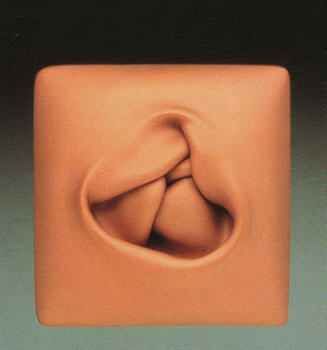The Work of Yuyen Chang
Chang's work is intentionally anthropomorphic, disturbingly so. She likens her technique to that of a plastic surgeon, shaping and sculpting on and beneath the surface, using traditional fabrication methods like die­forming, chasing, and repousse.
2 Minute Read
Should I look, or look away? In an instant, Yuyen Chang confounds the viewer. Her complicated work plays on our innate attraction to jewelry, its invitation to gaze, and our equally human repulsion from physical deformities: scars, growths, cysts, wounds. As baubles and boils incite these diametrically opposed responses, Chang's difficult pieces send one scrambling for the socially appropriate behavior.
| Untitled (brooch), "Orifice Series," 2001 Copper, 2x2x2″ Photo Jim Wildeman |
Yuyen Chang's work is intentionally anthropomorphic, disturbingly so. She likens her technique to that of a plastic surgeon, shaping and sculpting on and beneath the surface, using traditional fabrication methods like die-forming, chasing, and repousse. Yet Yuyen Chang's goal is hardly to beautify or' improve' her subjects; she labors to distort, to subvert. Though Chang made these pieces while still a student, she reveals an awareness of the allure-enhancing and status-bestowing powers of jewelry, especially in modern society, as well as our obsession with erasing any wrinkle, bulge, or flaw.
A most unusual jewelry artist, Chang bypasses witty and aims straight for unsettling. If one were simply to describe her navel- or mouth like brooches, they might seem wry or humorous, but in the flesh, as it were, her jewelry incites not a smile but a straight face-maybe even a wince. This is volatile territory, indeed; deformities are not a laughing matter. But our compulsion to look at them, Chang proves, is a fruitful topic for art indeed, especially art meant to be worn on the body.
Consider the brooches in her "Orifice Series'". At their center is an irregular orifice, from which poke crowded tongues? Fingers? Genitals? The brooches feel not quirky but creepy, sinister, abnormal. A similar sensation is elicited by a copper pendant in the same series. While finely executed, its bivalve, bloated form recalls a medical specimen, a detached organ, as if the owner were showing off her recently removed tonsils in a jar.
The brooches in Chang's most recent "Chi-Pa Series" assume more amorphic, growth-like contours. The artist coined the term "chi-pa" by combining the Chinese word for beauty or talent with that for scar or wound, to capture the ambiguous quality of these works. Yet the central, fleshy, woundlike gashes make it almost impossible to call them beautiful. One suspects a line of Yuyen Chang engagement rings is all but out of the question. Her intellectual yet visceral pieces defy not only social mores, but language as well. We're going to need a new vocabulary to praise this complex work.
You assume all responsibility and risk for the use of the safety resources available on or through this web page. The International Gem Society LLC does not assume any liability for the materials, information and opinions provided on, or available through, this web page. No advice or information provided by this website shall create any warranty. Reliance on such advice, information or the content of this web page is solely at your own risk, including without limitation any safety guidelines, resources or precautions, or any other information related to safety that may be available on or through this web page. The International Gem Society LLC disclaims any liability for injury, death or damages resulting from the use thereof.
The All-In-One Jewelry Making Solution At Your Fingertips
When you join the Ganoksin community, you get the tools you need to take your work to the next level.
Trusted Jewelry Making Information & Techniques
Sign up to receive the latest articles, techniques, and inspirations with our free newsletter.
